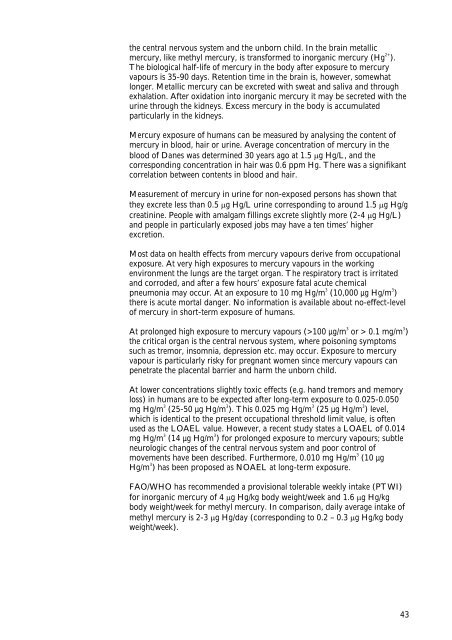No. 104 - Miljøstyrelsen
No. 104 - Miljøstyrelsen
No. 104 - Miljøstyrelsen
Create successful ePaper yourself
Turn your PDF publications into a flip-book with our unique Google optimized e-Paper software.
the central nervous system and the unborn child. In the brain metallic<br />
mercury, like methyl mercury, is transformed to inorganic mercury (Hg 2+<br />
).<br />
The biological half-life of mercury in the body after exposure to mercury<br />
vapours is 35-90 days. Retention time in the brain is, however, somewhat<br />
longer. Metallic mercury can be excreted with sweat and saliva and through<br />
exhalation. After oxidation into inorganic mercury it may be secreted with the<br />
urine through the kidneys. Excess mercury in the body is accumulated<br />
particularly in the kidneys.<br />
Mercury exposure of humans can be measured by analysing the content of<br />
mercury in blood, hair or urine. Average concentration of mercury in the<br />
blood of Danes was determined 30 years ago at 1.5 �g Hg/L, and the<br />
corresponding concentration in hair was 0.6 ppm Hg. There was a signifikant<br />
correlation between contents in blood and hair.<br />
Measurement of mercury in urine for non-exposed persons has shown that<br />
they excrete less than 0.5 �g Hg/L urine corresponding to around 1.5 �g Hg/g<br />
creatinine. People with amalgam fillings excrete slightly more (2-4 �g Hg/L)<br />
and people in particularly exposed jobs may have a ten times’ higher<br />
excretion.<br />
Most data on health effects from mercury vapours derive from occupational<br />
exposure. At very high exposures to mercury vapours in the working<br />
environment the lungs are the target organ. The respiratory tract is irritated<br />
and corroded, and after a few hours’ exposure fatal acute chemical<br />
pneumonia may occur. At an exposure to 10 mg Hg/m 3 (10,000 µg Hg/m 3 )<br />
there is acute mortal danger. <strong>No</strong> information is available about no-effect-level<br />
of mercury in short-term exposure of humans.<br />
At prolonged high exposure to mercury vapours (>100 µg/m 3<br />
or > 0.1 mg/m 3<br />
)<br />
the critical organ is the central nervous system, where poisoning symptoms<br />
such as tremor, insomnia, depression etc. may occur. Exposure to mercury<br />
vapour is particularly risky for pregnant women since mercury vapours can<br />
penetrate the placental barrier and harm the unborn child.<br />
At lower concentrations slightly toxic effects (e.g. hand tremors and memory<br />
loss) in humans are to be expected after long-term exposure to 0.025-0.050<br />
mg Hg/m 3 (25-50 µg Hg/m 3 ). This 0.025 mg Hg/m 3 (25 µg Hg/m 3 ) level,<br />
which is identical to the present occupational threshold limit value, is often<br />
used as the LOAEL value. However, a recent study states a LOAEL of 0.014<br />
mg Hg/m 3 (14 µg Hg/m 3 ) for prolonged exposure to mercury vapours; subtle<br />
neurologic changes of the central nervous system and poor control of<br />
movements have been described. Furthermore, 0.010 mg Hg/m 3 (10 µg<br />
Hg/m 3<br />
) has been proposed as NOAEL at long-term exposure.<br />
FAO/WHO has recommended a provisional tolerable weekly intake (PTWI)<br />
for inorganic mercury of 4 �g Hg/kg body weight/week and 1.6 �g Hg/kg<br />
body weight/week for methyl mercury. In comparison, daily average intake of<br />
methyl mercury is 2-3 �g Hg/day (corresponding to 0.2 – 0.3 �g Hg/kg body<br />
weight/week).<br />
43

















